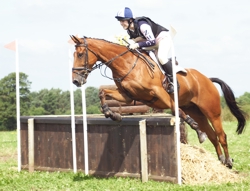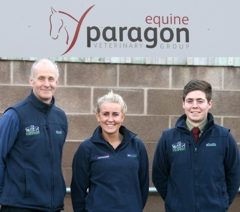Sudden onset lameness
So often significant lamenesses occur at competitions, but they can easily appear in horses at turnout where it is assumed they have been kicked by another horse, collided with the fence or a tree perhaps - or have simply slipped and fallen. The veterinary team at Paragon Equine in Cumbria explains more about sudden onset lameness.

Injuries at competitions commonly result from hitting a solid cross country fence, a fall either on the flat or whilst jumping or sometimes we see a horses that has pulled up lame with no obvious reason. Despite some of these horses being very lame, it can be difficult to establish the cause at this early stage, so the main priority is to get them to a place where they can cool down, away from the excitement of the competition, where they can be examined thoroughly. In some cases this may involve the use of a horse ambulance, but if it is judged that the horse is sound enough to walk back off the competition field and that walking will not make things worse, that walk can help to settle the patient and some lamenesses may appear to improve with a gentle walk. Back in the stable block or lorry park, the horse can be washed down and the process of evaluation can continue. If the underlying cause(s) cannot be established, the horse will treated symptomatically, according to the signs it is showing, and then re-examined at regular intervals.
A number of these cases resolve over 24 to 36 hours and the cause of the lameness is never established, however those horses in which lameness persists can be divided into two groups:
• Those with an obvious wound or swelling
• Those without heat, palpable pain or any clear swelling
The first group will be made up of the cuts and bruises, soft tissue injuries to tendons and ligaments, and fractures. During this first assessment it is important to provide the vet with a good history of the horse, which will vary depending on the individual circumstances, but include:
• Has it recently recovered from an injury and was a diagnosis reached?
• Does the horse have a history of tying up?
• Was it performing normally when the injury happened?
• Was there a kick or did it collide with a fence or any other object?
There are particular injuries that tend to be associated with different activities, for example harness racing compared with eventing or national hunt racing and being aware of more likely injury mechanisms can help with a lameness investigation.
In a competition environment, wounds can be cleaned and lavaged to remove any debris and during this process, the extent of deeper damage can be assessed. They can then be closed, or partially closed, using sutures or staples and bandaged appropriately. Bandaging may be needed to provide support for the journey home or to a treatment centre and this may include splinting if a fracture or severe tendon or ligament injury is suspected. As well as improving the comfort of the horse, this will minimise the risk of making the injury worse over the following few hours. Particular attention should be paid to the shoe and foot. Has the shoe moved or been pulled off and has the horse trodden on the shoe or nails?
Medical treatment can also begin at this stage and is most usually in the form of antibiotics and anti inflammatory medication. The site and nature of the injury can dictate how aggressive the treatment needs to be; for instance, even quite deep cuts to the face will heal quickly and without complication compared to a minor cut on the pastern. It is worth bearing in mind that a horse that has injured both fore limbs may be reluctant to move but may appear to be less severely affected than those with an injury to one leg alone. A careful examination of the whole horse is essential, even in cases where there is an obvious injury to one area.
Most horses can be made comfortable enough to be moved to a centre where further treatment or diagnostic work can take place.
The same process applies to the injuries sustained at home. These horses may be brought in from the field, lame and with no apparent cause. In some there may be a history of recent competition that can help to reveal a cause.
The horses with no obvious cause for the lameness can pose a challenge and it may take some time to establish the cause of the problem. The examination has to be thorough, and the vet will indicate how urgent they feel the need for investigation must be. For instance a mild forelimb lameness where the horse appears to be comfortable can be treated with box rest and may resolve over a short period of time. By contrast, a relatively comfortable horse with a hind limb lameness may go on to reveal over the next few days, a fractured pelvis, which may require the horse to be tied up or supported in slings.

The veterinary team at Paragon Equine in Cumbria is led by vet Paul May BVMS, MRCVS (left), supported by Sarah Glenn and Gregor Hepburn BVM&S, MRCVS. Visit www.paragonvet.com to get in touch.
This article first appeared in the July issue of Equine. If you would like to read more of these expert veterinary articles in Equine magazine, back issues are available for secure online purchase from www.theeequinestore.co.uk where you can also subscribe to Equine.



